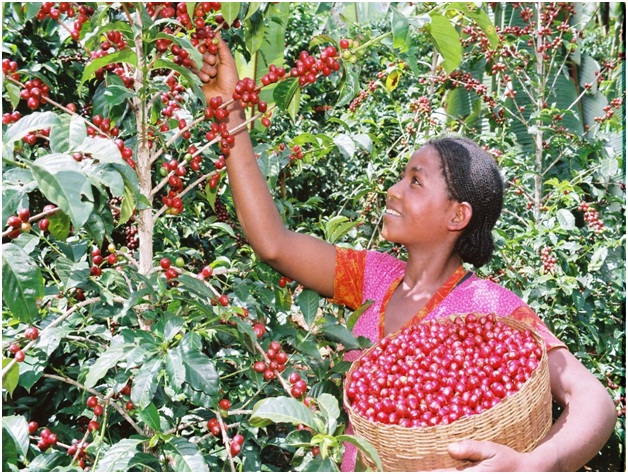
“Agriculture plays a backbone role in Ethiopia’s economy being core part to our vision for attaining prosperity,” Prime Minister Abiy Ahmed (PhD) said recently.
The Prime Minister mentioned some successes as a few of the milestones achieved so far in the past three years in the agriculture sector.
In order to strengthen market-led agricultural development system, 10 crop varieties are being developed in four States of the country on 3.2 million hectares of land in a cluster approach.
To facilitate the supply of irrigation rig and other agricultural equipment and inputs from the smallest to the largest, irrigation rigs and other inputs have been made tax-exempted at all levels and the inputs required for domestic production and assembly are equally tax-exempted.
Summer wheat farming which was being piloted two years ago on 3,500 hectares of land is expected to yield a harvest of up to 7 million quintals in the coming year.
Besides, during the 2021 fiscal year, 74,000 tons of rose and summer flowers were exported amounting 1.2 billion Birr.
According to the Ministry of Agriculture, more than 406 million quintals crop production was attained during the 2019/20 crop season. The effort exerted to utilizing adequate agricultural inputs and new agricultural technologies in the crop season said contributed more to harvest the indicated amount. Availing sufficient agricultural inputs supply, line seedling, special seeds distribution, market-oriented agriculture, clustered farming practices as well as coordinated efforts and active engagements of sector professionals enabled promising harvest in the country.
More importantly, more than 3 million hectares of land is cultivated with a cluster form of cultivation countrywide focused on market-oriented crops such as sesame, wheat, maize and barley. Following this, the overall performance of the agriculture sector is showing good progress year after year.
The country also withstands the repeatedly happened Deseret locust spread in some parts of the country and does not have a larger impact on the total crop production and productivity.
Currently, farmers are harvesting their crop production both manually and through the help of modern harvesting technologies (combiner) where the government gives emphasis towards expanding modern technologies application in the agriculture sector.
According to experts, new agricultural technologies’ expansion and accessibility throughout the country, as well as proper agricultural policies, activate Ethiopia’s crop production growing year after year. Farmers and pertinent stakeholders are also working hand in glove to prevent crop harvest and post-harvest damage that has been affecting the country’s annual agricultural harvest.
Currently, investors and pastorals are jointly developing wheat in lowland areas of Afar, Oromia and Somali regions which witnessed promising successes to be expanded into other areas of the country.
This endeavor enables the country to realize wheat self-sufficiency and able to supply the surplus product to the global market. The irrigation-based wheat production is said to be a transformation from import to export.
In recent years, Ethiopia has been making encouraging moves towards the utilization of its estimated 10.1 million hectares of irrigable land. In connection with this, the country organized a new Irrigation Commission (IC) in charge of leading the sector.
The Commission is responsible for the development of medium and large scale irrigation development projects. Currently, it is undertaking massive irrigation projects after undertaking a careful selection process and various feasibility studies.
The government has announced the implementation of numerous irrigation projects countrywide during the current budget year. The bidding process for other projects is also underway. The projects have mainly focused on improving the benefits of the youth by improving agricultural production and productivity. To this end, the Commission is facilitating ways to create jobs in large amounts for the youth. As a result, the youth will enter into fruit and vegetables, cash crop and other cereals production through the use of existing irrigation schemes.
The country’s favorable climate, fertile land and untapped water resources as well as the sound investment policies and vast human power make irrigation schemes profitable and feasible.
In line with the growing demand for avocado in the world market, 34,271 hectares of land were cultivated in cluster farming. To sustain the production, 264 nurseries were established and are operational. Ethiopia has suitable weather for growing avocado and the international market for avocado is rapidly growing. Experts said that if well invested in, avocado can take over coffee in a short period of time in terms of generating hard currency for Ethiopia.
Improved wheat production and productivity in the highlands is treated by intensification and treating acidification of wheat farms. 900,000 hectares of wheat farm land has been cultivated during this period employing these techniques, which has increased the overall wheat productivity by 13.9 percent at a national level.
By the same token, coffee productivity has been increased from 6.19 to 7.5 quintals per hectare. The total production has increased from 508,639 to 680,000 quintals by renovating 297,330 hectares of coffee grounds that stopped production due to ageing.
To improve fodder supply, especially in pastoral areas, 1,496 hectares of irrigated fodder has been developed over the past two years.
To improve veterinary health, coverage of vaccines based on risk has increased the past three years by 90 percent compared to the previous year.
Since the 2019 fiscal year, irrigation schemes on 121,356 hectares of land (individually and community-run) have been developed.
Over the past three years, 254 primary and secondary shopping centers have been built and organized in various regions.
In line with this, during the above mentioned period, 4.2 million permanent and temporary jobs have been created in seven sectors for rural, educated and uneducated people and school leavers living in rural areas. Of the jobs created in the past three years, 61 percent are created in the agricultural sector whereas 21 percent in the industrial sector, and 18 percent in the service sector.
Therefore, this data shows that the agriculture sector is still the highest employing sector in the country and is a means of live for most Ethiopians.
BY TEWODROS KASSA
The Ethiopian Herald May 21/2021





